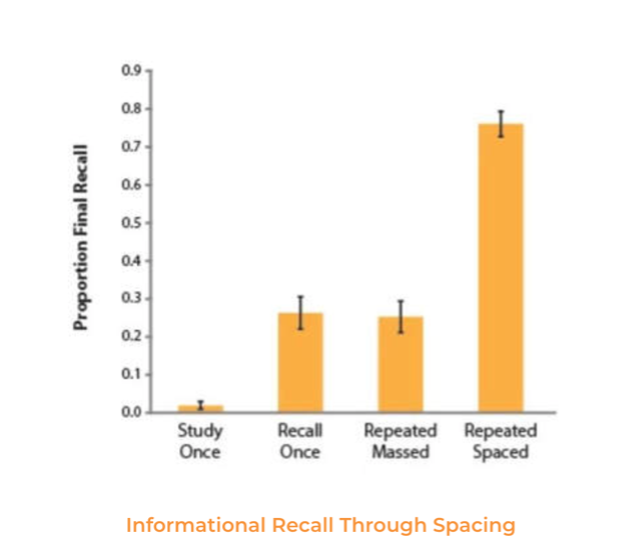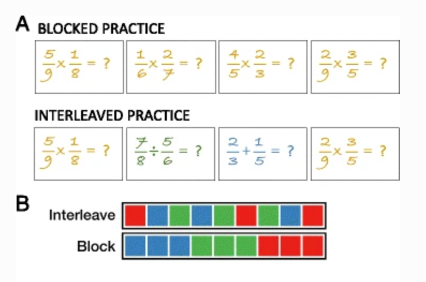70 Spaced and Interleaved Practice
Active Learning Strategies: Spaced and Interleaved Practice
Author: Justine Schultz
Editors: Elizabeth Harsma, Carrie Miller, and Michael Manderfeld
Explore these Spaced and Interleaved Practice topics:
- What is Spaced Practice?
- Example of Spaced Practice
- What is Interleaving?
- Example of Interleaving
- Strategies and Technology for Spaced and Interleaved Practice
- Even More Resources
What is Spaced Practice?
Spaced practice is organizing studying/learning activities into multiple sessions that are spread out over a longer period of time (Carpenter and Agarwal, 2020). Spaced practice is often used as part of retrieval practice techniques – learn more about retrieval in this article.

Image 1. Repeated spaced practice improves recall. Data from from Karpicke & Bauernschmidt (2011).
Spaced practice is often contrasted with cramming. Cramming is organizing learning/studying into one or very few sessions in a brief period of time, such as waiting to study until the night before an exam. Carpenter and Agarwal’s (2020) research suggests that cramming can be helpful for short-term learning but has little benefit for long-term retention. In contrast, spaced practice has significant benefit to long-term learning (Carpenter & Agarwal, 2020).
Examples of Spaced Practice
An example of spaced practice: Let us say you study on Monday and seem to understand all the content. Since you have learned about spaced practice, you decide to review again on Wednesday. It is clear you have forgotten some things, but now you are more confident in your learning, reviewing what you had forgotten. A week later you study the same material and notice you have forgotten some of the material, but not as much as last week. If you continue to study, increasing the time between review, it will only take a few more sessions to thoroughly imprint the material in your long-term memory (Murre & Dros, 2015).
What is Interleaving?
Interleaving is organizing studying/learning activities by varying or mixing up the topics or types of things studied (Rohrer, Dedrick, & Agarwal, 2017). Interleaving is often used as part of retrieval practice techniques – learn more about retrieval in this article.

Image 2. Blocking vs. interleaving strategy from Weinstein, Madan & Sumeracki (2018).
Interleaving is often contrasted with blocked learning. Blocking is when you practice all items of the same type at the same time, then move on to the next topic or type of learning activity. For example, practicing all addition problems, then all subtraction problems, then all multiplication problems, and then all division problems when studying mathematics. In contrast, interleaving has significant benefits to learning over blocked practice with learning performance increasing approximately 30% with interleaved practice (Roher & Taylor, 2007; Rohrer, Dedrick & Burgess, 2014). Interleaving also helps learners distinguish between related concepts and avoid confounding pattern recognition with learning (Agarwal & Bain, 2019).
Examples of Interleaving
Some examples of interleaving:
- Instead of practicing all addition problems, then all subtraction problems, you would study a few addition problems, then a few subtraction problems, then a few division problems, and so on.
- Instead of studying Lakota language for four hours straight, you would study programming for an hour, health for an hour, Lakota for an hour, and gender studies for an hour.
Strategies and Technology for Interleaved and Spaced Practice
Free Recall or Brain Dumps
A brain dump or free recall activity is an effective retrieval practice strategy that can easily incorporate spaced and interleaved variations (Agarwal & Bain, 2019; Brame & Biel, 2015).
The basics: Before class, after class, or during your lesson, lecture, or activity, pause and ask students to write down everything they can remember about a specific topic from memory. Be specific with your prompt and set a brief time limit (a few minutes). Make this activity low- or no-stakes and emphasize with students that it is a learning strategy, not an assessment.
- Spacing Strategy: In your brain dump prompt, ask students to write down one thing they remember from the lesson yesterday, last week, and/or within the last month.
- Interleaving Strategy: In your brain dump prompt, give students 1 – 3 key concepts from past units of learning mixed up with a few concepts from the current unit.
Free Recall activities can be completed using:
- Paper and pen/pencil
- Zoom Polls,
- Poll Everywhere Polls, and
- D2L Brightspace Assignments or Discussions, among other tools.
Blast from the Past Quizzes
Blast from the Past is a retrieval practice activity that already includes spacing and interleaving (Agarwal & Bain, 2019).
The basics: Engage students in recalling information across a variety of units and time frames using only their memory. Like other retrieval practice strategies, make this activity low- or no-stakes and emphasize with students that it is a learning strategy, not an assessment.
- Spaced Strategy: Re-take a quiz from a past unit worth low or no points.
- Interleaving Strategy: Create low or no-stakes quizzes with cumulative questions across diverse topics, units, or chapters of study.
Blast from the Past quizzes can be conducted with:
- Paper and pen/pencil,
- D2L Brightspace Quizzes,
- Zoom Polls,
- Poll Everywhere Polls, or
- Using a game like the Poll Everywhere Competition feature.
Learning Games
Transform retrieval practice strategies, like no-stakes quizzes, into a game. Interactive games enhance student engagement and increase academic performance (Chen, Huang, Gribbins, & Swan, 2018). Learn more about games, simulations, and gamification and in this article.
The basics: Create a list of key questions and answers specific to your learning objectives across one or more units, lessons, or chapters of study. As students play the game, ask students to only use their memories to try to answer correctly.
- Spacing Strategy: For example, you may pick questions that span across several different lessons (Multiplication problems using numbers 1-9).
- Interleaving Strategy: For example, you may include several different topics given from each lesson (Multiplication, Addition, Subtraction, Addition).
Variation on the strategy: Create a JEOPARDY! ® style quiz game show using PowerPoint or another game software. Create categories of concepts. Then add a list of key terms and concepts across various lessons, units of study, etc… into each category. Arrange terms in each category by easiest to most challenging on a game board. Label more challenging terms with more points or more “prize money.” Students take turns selecting concepts and answering by posing a question, for example, if the category is “Circulatory System” and the concept is “Blood,” the student would respond, “What is the transport medium for gases, nutrients, and waste in the body?”
Learning games can be conducted with:
- Paper and pen/pencil,
- Poll Everywhere Competition feature,
- Zoom Polls,
- Shared One Drive Word or PowerPoint Online document,
- And other game software or apps!
Spin the Wheel or Roll the Dice
Spin the wheel or roll the dice is another retrieval practice activity that already incorporates spacing and interleaving (Agarwal & Bain, 2019).
The basics: Select some general retrieval questions. You may use these questions or develop your own questions that will help with retrieval:
- What is an application or how can I use it?
- What is it similar to?
- What is it different from?
- What is an analogy to something in my daily life?
- How does it connect to something I knew previously?
- What is a fun way to remember it?
Create a digital wheel with the questions on it (example of a digital wheel). Alternatively, number the questions and use digital dice or a random list generator to select a question randomly.
Then create a list of key concepts specific to your course learning objectives, mixing up topics from one or more lessons, units, or chapters of study.
Individually or in small groups, students select a key concept from the list, spin the wheel/roll the dice, and then answer the selected question using only their memory.

Image 3. Digital wheel with retrieval questions
Even More Resources
Access various guides and strategies for teaching with retrieval practice at RetrievalPractice.org including a specific guide on Spacing and this guide on Interleaving.
Help students understand spaced and interleaved practice and improve their study skills with downloadable resources from The Learning Scientists blog.
Watch introductory videos, webinars, and key notes on RetrievalPractice.org’s YouTube channel.
References
Agarwal, P. K., Bain, P. M. (2019). Powerful Teaching: Unleash the science of learning. Wiley.
Agarwal, P. K., Roediger, H. L., McDaniel, M. A., & McDermott, K. B. (2020). How to use retrieval practice to improve learning. Retrieved Practice. Retrieved December 10, 2021, from https://orbit.texthelp.com/?file=http%3A%2F%2Fpdf.retrievalpractice.org%2 FRetrievalPracticeGuide.pdf.
Brame, C. J. and Biel, R. (2015). Test-enhanced learning: The potential for testing to promote greater learning in undergraduate science courses. CBE—Life Sciences Education 14, 1-12. The information in this guide has been published in CBE—Life Sciences Education (www.lifescied.org/content/14/2/es4.full.pdf+html).”
Chen, Huang, C. (Kathy), Gribbins, M., & Swan, K. (2018). Gamify online courses with tools built into your learning management system to enhance self-determined and active learning. Journal of Asynchronous Learning Networks JALN, 22(3), 41–. https://doi.org/10.24059/olj.v22i3.1466
Karpicke, J. D., & Bauernschmidt, A. (2011). Spaced retrieval: Absolute spacing enhances learning regardless of relative spacing. Journal of Experimental Psychology: Learning, Memory, and Cognition, 37(5), 1250-1257. https://doi.org/10.1037/a0023436
Murre, J. M., & Dros, J. (2015). Replication and analysis of Ebbinghaus’ forgetting curve. PloS one, 10(7), e0120644. https://doi.org/10.1371/journal.pone.0120644
Rohrer, D., & Taylor, K. (2007). The shuffling of mathematics problems improves learning. Instructional Science, 35, 481–498. https://doi.org/10.1007/s11251-007-9015-8
Rohrer, D., Dedrick, R. F., & Burgess, K. (2014). The benefit of interleaved mathematics practice is not limited to superficially similar kinds
of problems. Psychonomic Bulletin & Review, 21, 1323-1330. https://doi.org/10.3758/s13423-014-0588-3
Rohrer, D., Dedrick, R., Agarwal, P. (2017). Giving students a chance to learn what they need to know. Interleaved Mathematics Practice. Retrieved January 20, 2022, from https://orbit.texthelp.com/?file=http://pdf.retrievalpractice.org/InterleavingGuide.pdf
Weinstein, Y., Madan, C.R. & Sumeracki, M.A. (2018). Teaching the science of learning. Cognitive Research: Principles and Implications. https://doi.org/10.1186/s41235-017-0087-y

